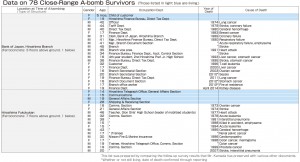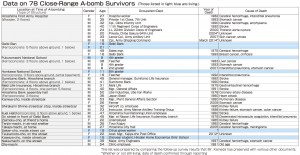Hiroshima: 70 Years After the A-bombing: Close-range Survivors: Introduction
Jul. 17, 2014
Record of 78 survivors
A 1946 report by the U.S. Strategic Bombing Survey stated that as a result of the atomic bomb that was dropped on Hiroshima on August 6, 1945, “In the immediate area of ground zero, the heat charred corpses beyond recognition.” Of those survivors who were within a 500-meter radius of the hypocenter, an area that received a devastating impact, 78 were still living in 1972. Detailed records of medical studies of those close-range survivors have been compiled over a period of more than 40 years by Nanao Kamada, 77, professor emeritus at Hiroshima University. He has organized the records and stored them in files that bear testimony to the inhumanity of nuclear weapons.
Doctor traces survivors
Bearing witness to inhumanity
“This group of survivors of exposure to a large amount of radiation is without parallel anywhere in the world,” Mr. Kamada said. “There are no other materials like this that offer such detailed medical and sociological data.” Beginning in the fall of 2012, Mr. Kamada went through the materials on each of the 78 survivors, including the 12 who are still living and organized them into files. They are stored under lock and key in a room in the city of Hiroshima.
Mr. Kamada classified the materials into categories including personal information such as injuries suffered in the A-bombing and medical histories, various kinds of basic research going back to 1946, “chromosome cards” for each individual that made it possible to estimate the amount of radiation they were exposed to, pathology-related photographs, recordings of interviews, and letters sent to him by the survivors. He has preserved some of the information electronically as well.
The survey of survivors within 500 meters of the hypocenter was undertaken by the Research Institute for Nuclear Medicine and Biology at Hiroshima University (now the Research Institute for Radiation Biology and Medicine (RIRBM)) in 1972. The survey expanded on a “Hypocenter Reconstruction Study” undertaken by the institute’s departments of epidemiology and social medicine starting in 1968.
At the time, there were growing calls for the government to put together a “white paper” outlining how people had been affected by the atomic bombing.
Kiyoshi Shimizu, then director of the research institute, research assistant Minoru Yuzaki, and others dug up information on the destruction within 500 meters of the hypocenter and published their results in a report that stated that the distance from the hypocenter “was closely related to the nature of the harm people suffered as a result of the atomic bomb.” (Mr. Shimizu died in 1991. Mr. Yuzaki, who later became a professor in the Faculty of Integrated Sciences, died in 1984.) Working with the local outlet of national broadcaster NHK, the institute’s team prepared a map that reproduced the hypocenter area.
In the process, they discovered a few survivors. In order to conduct their integrated scientific study, the researchers asked the survivors to enter a hospital where a detailed examination was conducted. The researchers also regularly surveyed all of the subjects of the study to follow up on their health.
Mr. Kamada, who specializes in hematology, participated in the project from the start. He looked into the rate of chromosomal abnormalities that occurred as a result of radiation exposure and in the 1980s established a method to biologically estimate the amount of radiation each person was exposed to. Starting in the 1990s, he discovered that an increasing number of survivors were suffering from more than one type of cancer and that there were numerous cases of meningioma in which tumors develop in the meningis, the membranous covering around the brain.
This knowledge has been used by the Hiroshima International Council for the Radiation-exposed (HICARE) to provide support to people who have been exposed to radiation and was put to use in health surveys of residents in the vicinity of Tokaimura in Ibaraki Prefecture following a criticality accident there in 1999.
“Because it was Hiroshima we were able to do it, and we had to do it,” Mr. Kamada said of his research, which was conducted through the cooperation of atomic bomb survivors. Mr. Kamada retired from his post as director of RIRBM in 2000. Since being named chairman of the board of the Hiroshima A-bomb Survivors Relief Foundation the following year, he has continued his research.
Evidencing his pride as a doctor, Mr. Kamada said, “Just because I left the university doesn’t mean I can just abandon people who are still suffering.”
Follow-up studies are becoming more difficult with the passing years as the survivors become ill and grow old. Consideration for the survivors’ families is also a factor. The 12 survivors reside in Hiroshima Prefecture and in other areas. The youngest, who is now 69, was 5 months old and being carried on her mother’s back at the time of the A-bombing. The oldest is 97. Mr. Kamada writes letters to them and takes advantage of holidays and business trips to visit them. He also answers questions from them about health-related matters over the phone. In this way he is continually adding to his records.
Mr. Kamada said he senses strength in the survivors. At the same time, “By looking at each of their lives, I can clearly see how much suffering the atomic bomb caused each of them, both physically and socially,” he said.
The records Mr. Kamada has compiled on the 78 survivors are not merely medical materials but information on individuals. He has carefully filed the materials both to bear witness to the inhumanity of nuclear weapons and to realize his desire as a medical researcher of Hiroshima that “after I’m gone someone can carry on the research.”
(Originally published on June 2, 2014)











